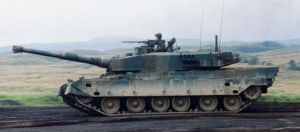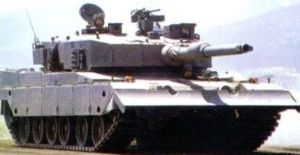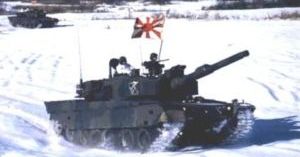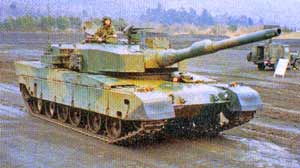| Designation: | Type 90 |
 |
|---|---|---|
| Manufacturer: | Mitsubishi Heavy Industries | |
| Product type: | Armoured Vehicles | |
| Name: | Main battle tank |
Research and development of a new MBT began in 1976 under the designation of the STC, subsequently called the TK-X, by the Technical Research Headquarters of the Japanese Self-Defence Agency.
Funding for the engine, gun, ammunition and fire-control system started in Fiscal Year 1977 with funding for the suspension and new armour in FY78.
Prime contractor for the Type 90 MBT is Mitsubishi Heavy Industries, which has also been prime contractor for all Japanese post-Second World War MBTs including the Type 74 and the Type 61.
With the exception of the 120 mm smoothbore gun, which is made under licence from Rheinmetall of Germany, the Type 90 and its subsystems are all designed and built in Japan.
Major subcontractors include Japan Steel Works, Mitsubishi Electric Corporation, Fujitsu Company and the NEC Corporation.
Requirements of the Type 90 were completed in 1980 with two prototypes, both armed with a Japanese 120 mm gun firing Japanese ammunition, completed in 1982 to 1984. These were used in extensive trials that continued through to 1986.
A second series of four prototypes was built between 1986 and 1988 which incorporated changes as a result of trials with the first two prototypes. These were armed with the Rheinmetall 120 mm smoothbore gun also fitted to the German Leopard 2 and, in a modified version, in the US M1A1/M1A2 Abrams MBT.
These prototypes were used for development and then user trials, all of which were completed by 1989.
The Type 90 was type classified in 1991 and it is estimated that by early 1999 about 150 Type 90 MBTs had been built with production still under way. The Mitsubishi Type 90 MBT and its variants have not been offered on the export market.
It is understood that under current plans a total of 96 Type 90 MBTs will be delivered to the Japanese Ground Self Defence Force between 1996 and the year 2000.
Description
No firm details of the armour type used in the construction of the Type 90 MBT have been released, but it is understood that extensive use of composite armour is made in both hull and turret over the frontal area of the tank. The Mitsubishi Steel Works and Kyoto Ceramic Company have been responsible for much of the armour development.
The layout of the Type 90 MBT is conventional with the driver's compartment at the front, turret in the centre and engine and transmission at the rear. The driver is seated at the front left and has a single-piece hatch cover with three periscopes being provided for forward observation; the centre one can be replaced by a passive periscope for night driving.
A quantity of 120 mm ammunition is stowed to the right of the driver's position.
The turret is similar to that of the German Leopard 2 MBT with vertical front, sides and rear and a bustle that extends well over the rear engine compartment.
The commander is seated on the right of the turret with the gunner on the left and the automatic loader being mounted in the turret bustle. Blow-out panels are provided in the turret bustle roof. The commander is provided with vision blocks for all-round observation and both commander and gunner have roof hatches.
Main armament comprises a 120 mm Rheinmetall smoothbore gun made under licence from Germany, which is fitted with a thermal sleeve, fume extractor and muzzle reference system. The ordnance and breech are identical to the German 120 mm smoothbore gun but the recoil system and gun mount were designed and built in Japan.
No details of the gun elevation/depression have been made available but it is probably similar to the Type 74 which has an elevation of +15° and a depression of -10° by pitching the hull forwards or backwards. Turret, traverse and weapon elevation are all-electric with manual controls for emergency use.
The 120 mm smoothbore gun is fed by an automatic bustle-mounted loader designed by Mitsubishi Heavy Industries. This is believed to hold a total of 16 rounds of ready use ammunition of the APFSDS-T or HEAT-MP type and can be loaded from insidethe Type 90 MBT or through a hatch in the turret roof. The ammunition has a semi-combustible cartridge case and all that remains after the weapon has fired is the stub cartridge case.
When the gun has fired, the ordnance returns to 0° elevation where it is loaded by the automatic loader, the gun then automatically returns to the firing position. Manual back-up of the automatic loader is possible.
A 7.62 mm machine gun is mounted coaxial to the left of the main armament and a 12.7 mm machine gun is mounted on the roof for anti-aircraft defence. This is mounted on the forward part of the turret roof so that it can be used by the commander or gunner. Mounted either side of the turret is a bank of three electrically operated smoke grenade dischargers firing forwards.
The fire-control system of the Type 90 includes a gunner's periscopic sight which is stabilised in azimuth, commander's periscopic sight with 180° traverse with dual-axis stabilisation and a digital fire-control computer.
The gunner's sight has a daylight channel, thermal sensor and an Nd:YAG laser range-finder.
The gunner's sight is provided by Nikon Corporation, commander's sight by Fuji Photo Optical Company and the thermal unit by Fujitsu Company.
The fire-control system includes an advanced auto-tracking capability that is based on the output of the thermal imager.
The automatic tracker is effective against ground targets and can be used when the Type 90 MBT is stationary or on the move.
When engaging without the auto-tracker, the gunner or commander uses his manual controls to track the target. To engage the auto-tracker, the commander or gunner only has to press the lock-on switch as soon as he has acquired the target and it falls within the lock-on gate in the sight.
If the target disappears temporarily, for example when it moves behind cover, the sight continues tracking at the same rate so that when the target reappears, the gunner can quickly lock-on again.
The commander's dual-axis stabilised sight, which only has a day capability, not only permits him to acquire and engage targets directly, but also provides a hunter killer capability. By pushing a button on his override control handle, the commander is able to hand-off a target that he has acquired to the gunner. The commander can then search for new targets while the gunner engages the first target.
In addition, the gunner's sight incorporates a thermal unit which is fed into two displays, one at the gunner's station and the other at the commander's. The tank commander also has unity vision blocks arranged to give 360° vision for surveillance.
The complete fire-control system provides a range of viewing options for both the commander and gunner, with redundancy provided by a back-up coaxial telescope mounted alongside the gun for use by the gunner.
The digital fire-control computer is the heart of the fire-control system. When engaging static and moving targets, calculations are made by the computer to compensate for range, wind (with the wind sensor being mounted on the turret bustle), temperature, gun tube bend (information from the muzzle reference system which is located on the left of the muzzle and is fed into the gunner's sight and fire-control computer), and cant angle (trunnion tilt).
Suspension of the Type 90 is of the hybrid type with torsion bars for the centre two roadwheels and hydropneumatic units for the first two and last two roadwheel stations, with six dual rubber-tyred roadwheels, drive sprocket at the rear, idler at the front and return rollers. The upper part of thetrack is covered by a lightweight skirt. The suspension enables the tank to change attitude in longitudinal direction only, for example on reverse slopes. Unlike the current Type 74, it will not be able to compensate for transverse changes.
The Mitsubishi 90° 10ZG is a two-stroke water-cooled direct injection diesel engine that uses an electric fuel-control system. It is supercharged by a Rootes blower, the engine having two exhaust turbochargers and an intercooler. Its maximum power of 1,500 hp is achieved at 2,400 rpm.
The engine is coupled to an automatic transmission which incorporates a torque converter with an automatic lock-up clutch in series with a four-speed planetary range box. Two speeds are available in reverse.
Hydrostatically controlled regenerative differential steering is utilised and oil-cooled multiple disc brakes are incorporated into the transmission.
The three engine cooling radiators are mounted above the transmission and are used together with three mixed flow fans. The fans are driven by hydraulic motors and are understood to be of the variable speed type depending on the engine and transmission temperatures. Air cleaners are located either side of the transmission.
Mounted on the forward part of the turret roof is a laser detector which provides an audible signal, as well as a direction indication, at the commander's station. This system can be used to automatically launch smoke grenades to counter heat-seeking missiles.
An NBC system is fitted as standard and a dozer blade can be mounted at the front of the vehicle if required.
- Type 78 Armoured Recovery Vehicle
The prototype of an ARV based on the chassis of the Type 74 MBT was completed in 1974 and standardised as the Type 78 ARV in 1978. In appearance it is very similarto the French AMX-30D and German Leopard 1 ARVs, with the crew compartment at the front, hydraulically operated dozer blade at the front of the hull and a hydraulic crane on the right side of the hull.
- Type 87 Twin 35 mm SPAAG
This is essentially a Type 74 MBT chassis fitted with a new two-person power-operated turret armed with twin 35 mm Oerlikon Contraves 35 mm KDA cannon, tracking and surveillance radars. Prototype systems were designated the AWX but production systems are known as the Type 87 twin 35 mm self-propelled antiaircraft gun system. The first production batch comprises a total of 12 vehicles.
Production complete. In service with the Japanese Ground Self-Defence Force.
|
||||||||||||||||||||||||||||||||||||||||||||||||||||||||||
|
||||||||||||
|
||||||||||||
 |
 |
 |
 |
 |
 |
 |
 |

